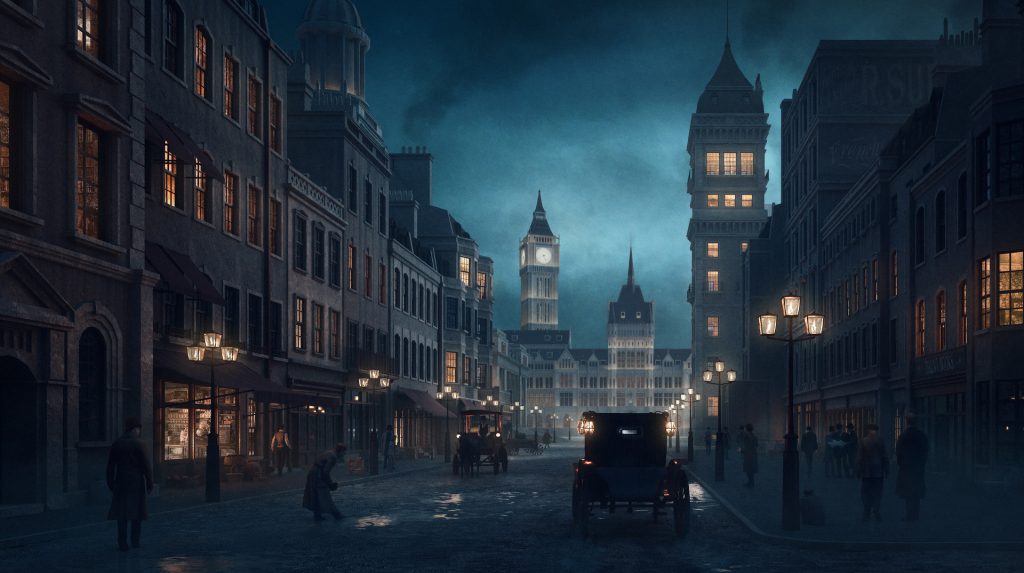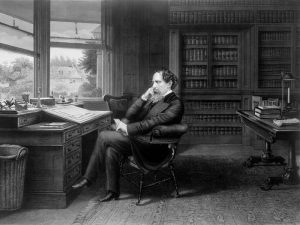A Dickensian Necropolis, our ‘new normal’ London
Posted in 1800-1899, 19th Century, Editorial blog posts, Literature, Places, Strandlines, contemporary, people, streets and roads, theatres and tagged with COVID-19, Charles Dickens, Literary London, London, London by Londoners, MyStrand, Victorian London, Waterloo Bridge, coronavirus, lockdown

As we entered a new decade, little did we know that three months down the line our bustling thoroughfare would come to be haunted by the shadows of London’s Victorian past.
Transforming into a flaneur-like figure in the dead of the night to combat his insomnia, Charles Dickens documented his traversing of London in the small hours in an essay titled, “Night Walks” (1860). 160 years on, there appears to be no discernible difference between slumbered Victorian London, and what defines our present-day ‘new normal’ city.

Charles Dickens in his Gad Hill’s study, at his writing desk. Image via Smithsonian Magazine.
Pacing through the capital’s streets, Dickens soon finds himself upon Waterloo Bridge. Dismissing the bridge only as ‘dreary’, he continues: ‘But the river had an awful look, the buildings on the banks were muffled in black shrouds, and the reflected lights seemed to originate deep in the water…’.
As we find ourselves thrust into an economic crisis, the obsolete, lifeless structures Dickens describes are no stranger to us. Filled with gothic, death-like imagery, Dickens paints a nightmare-ish scene of London, one that many people are living today.
Dickens soon finds himself amongst the great theatres of our Strand. Blazing lights, long queues, roar and chatter, are transformed with midnight and the writer’s trance,
‘Grim and black within… and lonesome to imagine, with the rows of faces faded out, the lights extinguished, and the seats all empty’.
Borrowing from Hamlet, Dickens’ deathly analogies return: ‘One would think that nothing in them knew itself at such a time but Yorick’s skull’. Entering the vacant theatre, he continues:
‘A dismal cavern of an immense aspect, with the chandelier gone dead like everything else, and nothing visible through mist and fog and space, but tiers of winding sheets… a ghost of a watchman, carrying a faint corpse-candle, haunted the distant upper gallery and flitted away… retiring within the proscenium, and holding my light above my head towards the rolled-up curtain – green no more, but black as ebony…’.
Life is replaced by spectres of what once was. Seeing the space transformed in an unprecedented manner leaves our narrative voice disoriented, bewildered, uncertain: sentiments many of us have been experiencing on a daily basis. The narrator continues his melancholy recollection: ‘My sight lost itself in a gloomy vault, showing faint indications in it of a shipwreck of canvas and cordage. Methought I felt much as a diver might, at the bottom of the sea’.

Nineteenth-century Strand. Image via speel.me.uk.
Following in the footsteps of Dickens,
‘The very shadow of the immensity of London seemed to lie oppressively upon the river’.
What is usually a city filled with traffic, noise, and the very opposite of social distancing, is now a hollow shell.
In the quotations I have gathered here, Dickens portrays a nightmare-ish Victorian capital… but also calls to mind scenes that some of us may have been experiencing day in and day out for months, whether we have been out exploring the streets, or are troubled by lockdown dreams.
Pervading this literary piece are death-like metaphors, analogies, and imagery – the bustling city has metamorphosed from a metropolis to a necropolis, figuratively for Dickens, but unfortunately, devastatingly literal for so many of us.
And yet. Eventually, the night comes to an end and Dickens retires from traversing the city of the dead.
Lockdown slowly but surely is easing, and life is beginning to return to our thoroughfare:
‘Now, too, the conscious gas began to grow pale with the knowledge that daylight was coming, and straggling workpeople were already in the streets, and, as waking life had become extinguished with the last pieman’s sparks, so it began to be rekindled with the fires of the first street corner breakfast-sellers. And so by faster and faster degrees, until the last degrees were very fast, the day came, and I was tired and could sleep’.
Repose returns to restless Dickens, and with it ghostly London dissipates. We, too, must remain in hope that normality is on the horizon.
To find out more about the nineteenth-century Strand, check out Théophraste Fady’s article: The Strand’s Foggy Past in Conan Doyle’s Work.

It’s odd for me to be finding some comfort in the extracts you’ve quoted from Dickens. Having been back and forth to the Strand in the last few months, there is an overwhelming sense of bleakness I’ve felt traversing familiar streets and places that now feel so alien. What was once familiar and a comforting second home stands empty and void of the bustle and intensity of city life.
I love the reference to Waterloo Bridge you cited – usually filled with commuters, tourists seeking the Strand and surrounding areas, it’s now a shell of what it used to be. But as you articulated so well, there is hope on the horizons.
Thank you, Sarah, for sharing some beautiful lines from Dickens and putting this together so well.
Thank you so much for reading, and leaving such thoughtful comments, Nura!
– Fran, assistant editor.